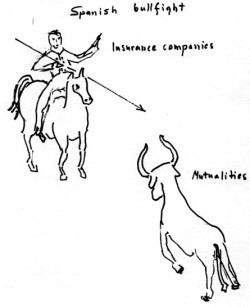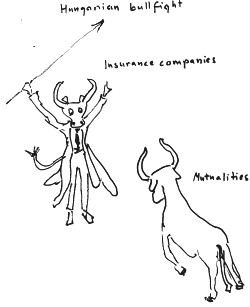 |
Health Insurance Development in Central and Eastern European Countries from the view of the possible Admission to the European Union, 2000 September 22nd Bratislava
The role of Mutualities in Health Care Financing in Central and Eastern Europe Illustrated by a Hungarian Example.
Prof. Árpád Skrabski PhD. President of the Hungarian Federation of Mutual Funds
Health in Hungary
Since the change to a market economy in 1990, Hungary has undergone rapid social and economic changes. This has put enormous pressure on the society to cope with economically, as well as psychologically and socially. The role of strong human resources such as high educational standards and life expectancy, and good health, is fundamental to work efficiency and thereby also competitive economic development. However, in 1999 the life expectancy in Hungary became one of the lowest in Europe and the mortality rate one of the highest, especially among middle aged men where the mortality rate in 1995 was higher than in 1934.
Table 1. Male death per 10000 male population by age group
| |
1930-31 |
1969-70 |
1979-80 |
1989-90 |
1996 |
1997 |
|
40-44 age group |
8.35 |
4.23 |
5.87 |
7.11 |
7.69 |
7.88 |
|
45-49 age group |
10.48 |
6.12 |
8.74 |
11.27 |
12.04 |
11.53 |
|
50-54 age group |
14.28 |
9.53 |
13.65 |
16.86 |
16.83 |
16.66 |
|
55-59 age group |
19.92 |
14.78 |
20.10 |
24.00 |
24.59 |
23.20 |
|
60-65 age group |
29.24 |
25.80 |
29.65 |
34.19 |
33.05 |
33.05 |
| KSH Demographic Yearbook 1997. |
|
Since the increase in GDP per capita between the early 1970s and the late 1980s went together with the deterioration of health of the population, at least in a certain extent, it is fairly probable that other factors than economic ones have had an impact on health; these are psychosocial and behavioural.
Legal framework of the mutualities inside the health care financing
The Hungarian health care and financing social security system had not been able to cope with the problem of worsening health status of the population. The reform of the social security system began at 1987 with the help of the UNDP, the Association International de la Mutualité and the Mutualité Francaise. The main issue of the report of this preparatory work of the reform was strengthening the social security system with a complementary system based on mutualities.
After the political change the new Government recognised the importance of empowering individuals through civil engagement This was a real political change, because movements from the ground up and the foundation of social organisations were regarded as defiance of the state in Hungary until the end of the 1980s. From the end of the 1980s civil associations and foundations could be established without any fear of retaliation or administrative difficulties. The legislation and foundation of voluntary mutual benefit funds (VMBFs), as civil organisations with a new legal entity, took part in the government programme.
The English translation of the name of this organisation is misleading; these organisations were founded only by natural persons, therefore the best English translation could be "friendly society" and French translation is "mutualité".
Among the AIM members there are two types of civil, not-for-profit, voluntary organisations:
- organisations which are based on unification of natural persons such as mutualité, friendly society, Kranken Kasse and
- organisations which are based on unification of capital such as providence or fund.
The governing body in the case of the friendly society type organisations is elected by the members, and in the case of providence type organisations by the founders. The highest level of decision making in the case of friendly society is the general assembly, and in the case of providence is the meeting of the trustees. The representation of the members in the governing body of the organisation is 100 % in the case of the friendly society and a relatively low level, or 0 % in the case of a providence.
The Hungarian VMBFs are based on unification of natural persons, the founders and members are the owners and the beneficiaries of this society. One type of these organisations is the health funds. According to the involvement of the members in the activity of the "health funds" these organisations are good tools to influence the members and their healthy behaviour. So in the case of health funds the type of organisation could be a factor, which help in decrease of risk of illnesses. According to a decree of the Hungarian Government at 1998, the health funds could be owners of inpatient and outpatient clinics and other provider institutions. In that case the health fund have to be the only owner. The Hungarian law was based on the French Law on Mutualities.
On 6 December 1993 the Law on Voluntary Mutual Benefit Funds (VMBFs) came into force. The health funds have tree roles namely financing the health providers, providing health care and helping the members to be involved in the health promotion process and to be responsible for their own health. The role of the health funds could be financing the prevention, the health promotion, the rehabilitation, the dentist, occupational health and sanatorium care, because they are complement of the social security. On the other hand the health funds could make the members active partner in the intervention for healthy way of life. The health funds are almost the only institutions which realise financial interest in decreasing the risk of worsening health status of the population through the implementation of community based interventions among their members. Such programmes are successful only if the civic society is actively involved. The health funds being civil association, could be successful institutions in strengthening the social capital in the changing society.
Mutualities could be founded in tree different legal forms, they are different in the point of view of legal framework, supervision and tax benefit. All of these are friendly society type organisations, independent and complementary to the social security.
Table 3. Legal framework of mutualities in Hungary
|
|
Name of the legal entity
|
Legal basis |
Supervision |
|
Voluntary mutual benefit funds (health or self help funds and pension
funds) |
Law on VMBFs |
State Office for Supervision of the Monetary Organisations |
|
Insurance association |
Insurance Law |
State Office for Supervision of the Monetary Organisations |
|
Mutual friendly societies
|
Civil Law |
Office of Attorney |
In the Hungarian Pension system there are private pension funds, which are friendly society type organisations, part of the social security system and obligatory for the young beginners. The members of the private pension funds pay a decreased contribution to the social security, and received only 75 % of their social security pension. The other part of the contribution is paid to the private pension funds for a founded private pension. The for-profit insurance companies make an effort to legalise a similar organisation on the field of financing health care.
In the free market economy, there are a strong competition between the mutualities and the insurance companies. The contributions of the insured persons in a for-profit insurance product depend on the risk of the persons. This means that the healthy young persons with low risk could buy a cheap health insurance and the ill, old and poor persons remain in the mutualities or in the social security system. The mutualities are in a bad position in this competition, and are forced to become for-profit insurance companies to keep their positions in the market. As a result of this process a huge part of the population can't buy health insurance and remain out of the health care financing system. For example in the US 50-60 million people are out of the financing system.
A very strange situation emerged in the Hungarian pension system. Instead of competition, the insurance companies gave support to the foundation of the mutualities (pension funds), at the same time they make them dependent from the bestower insurance company who in contractual form provide them administration, investment etc. According to the Law on the VMBF's, on the private pension funds and the Civil Law this activity is illegal. So the biggest pension funds are in illegal position and could be punished by the supervision. We can compare this situation with a Spanish bullfight, where the toreador symbolised the insurance companies being a strong position against the bull symbolised the mutualities. In the Hungarian bullfight the toreador has a bull-mask and is in an illegal, uncomfortable position.
|


The same could happen in the health care financing system, where for-profit companies (banks, drug companies) supported the foundation of a health fund and make this health fund dependent from them. The service of this fund could be the reimbursement of the co-payment of the member's payment for drugs. Because the tax benefit of the services of health funds, this solution could be profitable, but do nothing for the health of the members.
The solution could be strengthening the legal and decreasing the illegal activities of the health funds and find their role in the health financing and providing system.
Report in 1999 on health care financing in Hungary
There are two basis of the health care financing system, they are the social security institutions and the health funds. The health funds were funded in a so called "green field" way. They show a slowly but stabile development as a complement institution of social security.
Table 4. Receipts and expenditures of the health insurance fund budgeted for 1999
|
| |
1999 |
|
Expenditures |
Original quota |
Altered quota |
Granted |
|
1. Disability related pension provision |
117.684 |
115.684 |
154.445 |
|
2. Money supplied by health insurance (disability allowance, pregnancy-,
confinement benefit, illness-related allowances) |
56.932 |
56.932 |
58.790 |
|
3. Provision in kind |
500.531 |
512.199 |
504.069 |
|
3.1. Healing-preventing provision |
350.165 |
345.765 |
338.877 |
|
3.2. Subvention of remedies/medicine |
122.932 |
141.000 |
139.461 |
|
3.3. Support of therapeutical equipment |
22.582 |
20.582 |
20.589 |
|
3.4. Other (recoupment of expenses for pay-offices, postage and other
expenses) |
1.788 |
1.788 |
1.975 |
|
4. Expenditures assigned to functioning |
18.999 |
18.761 |
19.174 |
Table 5. Vountary Mutual Benefit Funds and Private Pension Funds |
| |
Private Pension Funds |
Voluntary Pension Funds |
Voluntary Health Funds |
Voluntary Mutual Benefit Funds |
|
Number of funds |
30 |
145 |
25 |
18 |
|
Number of members |
2.064.413 |
1.007.360 |
48.516 |
46.096 |
|
Membership fee (thousand HUF) |
57.675.626 |
55.177.007 |
1.957.861 |
1.900.532 |
|
Capital (thousand HUF) |
89.775.262 |
159.587.689 |
1.917.392 |
1.159.623 |
|
Number of funds - registered funds with proper activity, functioning and meeting the reporting requirements
Number of members - number of members registered at the end of 1999.
Receipts of membership-fees at private pension funds - membership fee type payments received in the course of 1999 (membership fee paid by members, membership fee rounding out paid by members, membership fee rounding out paid by employer, membership fee received subsequently).
Receipts of membership-fees at voluntary funds - membership fee type payments received in the course of 1999 (membership fee paid by members, contribution paid by employer, cover supports)
Capital - closing payroll of investments registered at the end of 1999.
The budget of health care financing of social security was 504 billion and the membership fee of health and self-help funds was 3.9 billion. The membership fee was under 1 % (0,77 %) of the social security contribution. It have to be 15-20 % if the health funds are local administration of social security as contractual partners.
Role of mutualities in the health care reform
This could be a political decision to build a health care financing system where the local administration of the social security could be executed by the health funds in a contractual way. The present government programme includes the insertion of health funds in the health care financing system. "The health care financing based on solidarity principle and built on contributions is regarded by the government as the source of basic insurance. The task of the social security system is to keep a record of contributions and to distribute the collected contributions among health funds in accordance with per capita". The funds contracting with the social security "provide basic insurance to all citizens, and further complementary insurance according to contract concluded." "This provides opportunity for private and community initiations."
According to the Hungarian Law the complementary health funds could finance only that services which are not financed by the social security. This was the reason that the health funds offer to their members the financing of health promotion and prevention. In the reformed health care system the health funds could finance
- - the "basic insurance", where the source could be the social security contribution and
- - complementary services including health promotion and prevention, where the source could be the voluntary membership fee.
In the reformed financing health care system the Hungarian health funds could have an emphatic roll in financing health promotion and prevention.
|

|
 |



